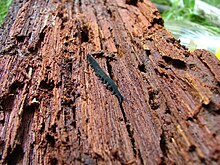
The lobopodians, members of the informal group Lobopodia, or the formally erected phylum Lobopoda Cavalier-Smith (1998), are panarthropods with stubby legs called lobopods, a term which may also be used as a common name of this group as well. While the definition of lobopodians may differ between literatures, it usually refers to a group of soft-bodied, worm-like fossil panarthropods such as Aysheaia and Hallucigenia.

Onychophora, commonly known as velvet worms or more ambiguously as peripatus, is a phylum of elongate, soft-bodied, many-legged panarthropods. In appearance they have variously been compared to worms with legs, caterpillars, and slugs. They prey upon other invertebrates, which they catch by ejecting an adhesive slime. Approximately 200 species of velvet worms have been described, although the true number of species is likely greater. The two extant families of velvet worms are Peripatidae and Peripatopsidae. They show a peculiar distribution, with the peripatids being predominantly equatorial and tropical, while the peripatopsids are all found south of the equator. It is the only phylum within Animalia that is wholly endemic to terrestrial environments, at least among extant members. Velvet worms are generally considered close relatives of the Arthropoda and Tardigrada, with which they form the proposed taxon Panarthropoda. This makes them of palaeontological interest, as they can help reconstruct the ancestral arthropod. In modern zoology they are particularly renowned for their curious mating behaviours and the bearing of live young in some species.

Panarthropoda is a proposed animal clade containing the extant phyla Arthropoda, Tardigrada and Onychophora. Panarthropods also include extinct marine legged worms known as lobopodians ("Lobopodia"), a paraphyletic group where the last common ancestor and basal members (stem-group) of each extant panarthropod phylum are thought to have risen. However the term "Lobopodia" is sometimes expanded to include tardigrades and onychophorans as well.

Euperipatoides is a genus of ovoviviparous velvet worms in the family Peripatopsidae. All species in this genus have 15 pairs of legs in both sexes. All species are found in New South Wales, Australia. E. rowelli is also found in the Australian Capital Territory.
Aktinothele is a monospecific genus of oviparous velvet worm, containing the single species Aktinothele eucharis. This species has 15 pairs of legs in both sexes. The type locality of this species is Finch Hatton Gorge, Queensland, Australia.
Baeothele is a monospecific genus of ovoviviparous velvet worm containing the single species Baeothele saukros. This species has 15 pairs of legs in both sexes. The type locality of this species is Wollemi National Park, New South Wales, Australia.
Centrorumis is a monospecific genus of velvet worm containing the single species Centrorumis trigona. This species has 15 pairs of legs in both sexes. It is found in New South Wales, Australia.
Leuropezos is a monospecific genus of velvet worm containing the single species Leuropezos eungellensis. This species has 15 pairs of legs in both sexes. The type locality of this species is Eungella National Park, Queensland, Australia.

Occiperipatoides is a monospecific genus of velvet worm containing the single species Occiperipatoides gilesii. This genus is ovoviviparous and found in Western Australia. The genus is part of the ancient phylum Onychophora that contains soft-bodied, many-legged relatives of arthropods known commonly as velvet worms.
Phallocephale is a monospecific genus of ovoviviparous velvet worm containing the single species Phallocephale tallagandensis. Males are distinguished by the presence of an eversible knoblike structure on the head, whereas females instead have a depression on their head. The type locality of this species is Tallaganda National Park, New South Wales, Australia.
Nodocapitus is a genus of velvet worms in the family Peripatopsidae. All species in this genus have 15 pairs of legs in both sexes. N. formosus is found in Queensland, Australia, N. inornatus is found in New South Wales, and N. barryi is found in both of these states. In each species, the males are distinguished by enlarged papillae on the head, between the antennae.
Paropisthopatus is a monospecific genus of velvet worm containing the single species Paropisthopatus umbrinus. Females of this species range from 20 mm to 70 mm in length. The type locality is in central Chile. Velvet worms in this genus have 16 pairs of legs.

Euperipatoides rowelli is an ovoviviparous species of velvet worm of the Peripatopsidae family. It is found in New South Wales and the Australian Capital Territory.
Opisthopatus cinctipes is a species of velvet worm in the Peripatopsidae family. This species has 16 pairs of legs, all with claws and all used for walking. Females range from 7 mm to 50 mm in length, whereas males range from 6 mm to 36 mm. The type locality is in South Africa.
Hylonomoipos brookensis is a species of velvet worm in the Peripatopsidae family. This species has 15 pairs of legs in both sexes. It is found in Queensland, Australia.
Nodocapitus inornatus is a species of velvet worm in the family Peripatopsidae. The type locality of this species is Gibralter Range National Park, New South Wales, Australia. This species has 15 pairs of legs in both sexes. The males are distinguished by enlarged papillae on the head, between the antennae.
Ruhbergia bifalcata is a species of velvet worm in the family Peripatopsidae. The type locality is in New South Wales, Australia.
Ruhbergia brevicorna is a species of velvet worm in the Peripatopsidae family. The type locality is in New South Wales, Australia.
Ruhbergia rostroides is a species of velvet worm in the Peripatopsidae family. The type locality is in New South Wales, Australia.
Planipapillus mundus is a species of velvet worm in the Peripatopsidae family. It is found in New South Wales, Australia.





